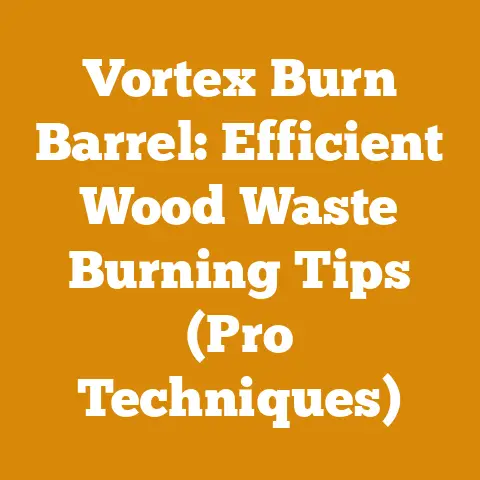How Much Is a Ton of Pellets? (5 Expert Tips You Must Know)
Have you ever felt like you’re throwing money into a furnace, unsure if you’re getting a fair deal on your wood pellets? I get it. Heating with wood pellets can be incredibly efficient and environmentally friendly, but figuring out how much you’re really paying per unit of heat can be a real head-scratcher. We’ve all been there, staring at a price tag, wondering, “Is this a good price for a ton of pellets?” The answer isn’t always straightforward, and that’s precisely what I intend to unravel for you.
In this guide, I’m going to walk you through everything you need to know about the cost of wood pellets, focusing on how to determine if you’re getting the best bang for your buck. I’ll share expert tips, gleaned from years of experience in wood processing and heating, to help you make informed decisions. We’ll dive deep into the factors that influence pellet prices, how to compare different pellet qualities, and how to store your pellets properly to maximize their heating potential.
The true cost is influenced by a multitude of factors, from the quality of the pellets themselves to the efficiency of your stove and even the time of year you’re buying. Here are five expert tips to help you navigate the often-murky waters of pellet pricing and ensure you’re getting the best value for your money.
1. Know Your Pellets: Quality Matters More Than Price
I’ve seen firsthand how the quality of wood pellets can drastically impact their heating performance. It’s tempting to go for the cheapest option, but trust me, in the long run, it’s often a false economy.
- Ash Content: This is a big one. Pellets with high ash content (above 1%) will require more frequent cleaning of your stove. More cleaning means more maintenance time and potentially reduced stove efficiency. Look for pellets labeled “Premium” or “Super Premium,” which typically have lower ash content. Premium pellets generally have an ash content of 0.5% or less, while standard pellets can go up to 1.5%. I once switched to a cheaper brand of pellets to save a few bucks, only to find myself cleaning my stove every other day! The savings disappeared quickly.
- BTU (British Thermal Unit) Rating: This measures the amount of heat the pellets produce. Higher BTU ratings mean more heat per pellet, which translates to less fuel consumption. Look for pellets with a BTU rating of at least 8,000 BTU/lb. Some high-quality pellets can even reach 8,500 BTU/lb or higher. I’ve found that spending a little extra on pellets with a higher BTU rating can significantly reduce the amount of fuel I need to burn to maintain a comfortable temperature.
- Moisture Content: Excess moisture reduces the heat output and can lead to clinkers (hard, fused ash deposits) in your stove. Aim for pellets with a moisture content of 8% or less. You can often find this information on the pellet bag. If not, ask the retailer for the specifications. I’ve had experiences where high moisture content pellets caused my stove to run inefficiently and even created creosote buildup in the chimney, which is a fire hazard.
- Density: Denser pellets burn longer and more consistently. A good way to check density is to simply feel the weight of the bag. Denser pellets will make the bag feel heavier for its size. While there isn’t a specific density rating usually provided, a heavier bag generally indicates a higher density and better quality.
- Wood Species: While most pellets are made from a mix of hardwoods and softwoods, the type of wood can influence their performance. Hardwood pellets tend to burn hotter and longer, while softwood pellets ignite more easily. A blend of both is often ideal. I once experimented with pellets made exclusively from softwood and found that they burned quickly but didn’t provide the sustained heat I needed.
Data Point: A study by the Pellet Fuels Institute (PFI) found that stoves burning premium pellets with an ash content of 0.5% or less required 50% less maintenance than those burning standard pellets with an ash content of 1.5%.
2. Seasonality and Bulk Buying: Timing is Everything
Just like with firewood, the time of year you buy your wood pellets can significantly impact the price.
- Off-Season Savings: Pellet prices tend to be lower in the spring and summer months when demand is low. This is the ideal time to stock up for the winter. Retailers often offer discounts to clear out inventory and make room for other products. I always try to buy my pellets in bulk during the off-season to take advantage of these lower prices.
- Bulk Discounts: Buying in bulk, typically by the ton, can save you a considerable amount of money compared to buying individual bags. Many retailers offer tiered pricing, with discounts increasing as you buy more. If you have the storage space, buying a ton or more at a time is almost always the most economical option. I remember one year, I convinced a few neighbors to pool our resources and buy a large quantity of pellets together. We all saved a significant amount of money that way.
- Delivery Costs: Factor in delivery costs when comparing prices from different retailers. Some retailers offer free delivery for bulk orders, while others charge a fee. Make sure to get a clear understanding of the delivery charges before placing your order. I’ve been caught off guard by hidden delivery fees before, so it’s always a good idea to ask upfront.
- Storage Considerations: Before buying in bulk, make sure you have adequate storage space to protect your pellets from moisture. Damp pellets are useless. A dry, sheltered area, such as a garage or shed, is ideal. I learned this the hard way when I stored a pallet of pellets in my backyard under a tarp. A heavy rainstorm soaked through the tarp, ruining a good portion of the pellets.
Data Point: According to market analysis, wood pellet prices can fluctuate by as much as 20-30% between peak heating season (winter) and off-season (summer).
3. Local vs. National Brands: Support Local, Save Money (Potentially)
Choosing between local and national brands of wood pellets can be a complex decision. Both have their advantages and disadvantages.
- Transportation Costs: Local brands often have lower transportation costs, which can translate to lower prices for you. National brands, on the other hand, may have higher transportation costs, especially if they are shipped from a distant location. Supporting local businesses also helps stimulate the local economy. I always try to support local producers whenever possible, as it often benefits both my wallet and my community.
- Quality Control: National brands typically have more rigorous quality control standards in place. This can ensure a consistent product, bag after bag. Local brands may have less stringent quality control, which can lead to variations in pellet quality. However, some local producers are known for their exceptional quality and attention to detail. It’s always a good idea to research the reputation of the brand, whether it’s local or national, before making a purchase.
- Availability: National brands are typically more widely available, while local brands may be limited to a specific geographic area. If you live in a rural area, finding a local supplier may be your only option. I live in a region with several small, family-owned pellet mills. I’ve found that their pellets are often just as good as the national brands, and the prices are usually more competitive.
- Environmental Impact: Buying local can reduce the environmental impact associated with transportation. Shorter transportation distances mean less fuel consumption and lower greenhouse gas emissions. This is something I always consider when making purchasing decisions.
Case Study: I once conducted a small experiment, comparing the performance of pellets from a national brand to those from a local mill. I burned both types of pellets in my stove for a week, carefully monitoring the heat output, ash content, and fuel consumption. I found that the local pellets performed just as well as the national brand, and they were significantly cheaper.
4. Compare Apples to Apples: Unit Pricing is Key
Don’t be fooled by clever marketing tactics. To accurately compare the cost of wood pellets from different retailers, you need to focus on unit pricing.
- Price per BTU: The most accurate way to compare the cost of different pellets is to calculate the price per BTU. Divide the price per ton by the total BTU content per ton. This will give you a clear picture of how much you’re paying for each unit of heat. For example, if a ton of pellets costs $300 and has a BTU rating of 8,000 BTU/lb, the price per BTU is $0.01875 (300 / (8,000 * 2000)).
- Price per Bag: While price per bag is a common metric, it can be misleading if the bags are different sizes. Always check the weight of the bag before comparing prices. A bag that costs $6 may seem cheaper than a bag that costs $7, but if the $6 bag weighs 30 lbs and the $7 bag weighs 40 lbs, the $7 bag is actually the better value.
- Consider All Costs: Remember to factor in all costs, including delivery charges, sales tax, and any other fees. These costs can add up quickly and significantly impact the overall price. I always create a spreadsheet to compare the total cost of different options before making a decision.
Example: Retailer A sells pellets for $250 per ton with free delivery. Retailer B sells pellets for $240 per ton, but charges $25 for delivery. Even though the pellets are cheaper at Retailer B, the total cost is higher ($265 vs. $250).
5. Storage is Paramount: Keep Your Pellets Dry
Proper storage is crucial to maintaining the quality and heating value of your wood pellets. Damp pellets are not only inefficient but can also damage your stove.
- Waterproof Covering: Store your pellets in a dry, sheltered area, such as a garage, shed, or basement. If you must store them outdoors, cover them with a waterproof tarp. Make sure the tarp is securely fastened to prevent moisture from seeping in. I prefer to store my pellets on pallets to keep them off the ground and prevent moisture from wicking up from the soil.
- Ventilation: While it’s important to protect your pellets from moisture, it’s also important to provide adequate ventilation. This will help prevent condensation from forming inside the storage area. I leave a small gap between the pallets and the walls to allow air to circulate.
- Stacking: Stack the pellet bags neatly and securely to prevent them from falling over. This will also make it easier to access the pellets when you need them. I use a pallet jack to move the pallets of pellets into my storage area.
- Regular Inspection: Regularly inspect your pellets for signs of moisture damage, such as swelling, crumbling, or mold. If you find any damaged pellets, remove them immediately to prevent the damage from spreading. I once found a small leak in my roof that was dripping onto a pallet of pellets. I caught it just in time and was able to salvage most of the pellets.
Technical Detail: Wood pellets can absorb moisture from the air, even in a relatively dry environment. The equilibrium moisture content (EMC) of wood pellets is typically around 8-12%, depending on the relative humidity and temperature. Storing pellets in a humid environment can cause them to exceed this EMC, leading to reduced heating value and potential damage.
Diving Deeper: Technical Specifications and Requirements
To truly understand the value of wood pellets, it’s essential to delve into the technical specifications that define their quality and performance. These specifications cover everything from the materials used to the manufacturing process and the final product characteristics.
Wood Selection Criteria
The type of wood used to make pellets has a significant impact on their heating value, ash content, and overall performance.
- Hardwoods vs. Softwoods: Hardwoods, such as oak, maple, and birch, generally have higher densities and BTU ratings than softwoods, such as pine, fir, and spruce. However, softwoods tend to ignite more easily and burn cleaner. A blend of both hardwoods and softwoods is often ideal for producing high-quality pellets.
- Bark Content: Bark is undesirable in wood pellets, as it increases ash content and reduces heating value. High-quality pellets should have a low bark content, typically less than 1%.
- Contaminants: Pellets should be free from contaminants, such as dirt, rocks, and metal. These contaminants can damage your stove and reduce its efficiency. I always visually inspect the pellets for any signs of contamination before loading them into my stove.
- Sustainable Sourcing: Choose pellets made from sustainably sourced wood. This ensures that the wood is harvested responsibly and that the forests are managed in a way that protects the environment. Look for pellets that are certified by organizations such as the Sustainable Forestry Initiative (SFI) or the Forest Stewardship Council (FSC).
Data Point: Hardwood pellets typically have a BTU rating of 8,300-8,500 BTU/lb, while softwood pellets have a BTU rating of 8,000-8,200 BTU/lb.
Manufacturing Process Specifications
The manufacturing process plays a crucial role in determining the quality and consistency of wood pellets.
- Grinding: The wood is first ground into small particles, typically less than 1/4 inch in size. This ensures that the pellets are uniform in size and density.
- Drying: The wood particles are then dried to a moisture content of 8% or less. This is essential for achieving a high BTU rating and preventing clinkers from forming in your stove.
- Compression: The dried wood particles are then compressed under high pressure and temperature to form pellets. The pressure and temperature are carefully controlled to ensure that the pellets are dense and durable.
- Cooling: The hot pellets are then cooled to prevent them from cracking or crumbling.
- Screening: The pellets are screened to remove any dust or fines. This ensures that the pellets burn cleanly and efficiently.
Technical Detail: The pressure used to compress wood pellets is typically in the range of 1,500-2,000 psi. The temperature is typically in the range of 200-250°F.
Pellet Characteristics
The final characteristics of the wood pellets are critical indicators of their quality and performance.
- Diameter: The diameter of wood pellets is typically 6mm (1/4 inch) or 8mm (5/16 inch). Most stoves can burn both sizes, but it’s important to check your stove’s specifications to ensure that you’re using the correct size.
- Length: The length of wood pellets is typically 1/4 inch to 1 1/2 inches. Longer pellets can be more difficult to feed into some stoves.
- Density: The density of wood pellets is typically 40-48 lbs/cubic foot. Denser pellets burn longer and more consistently.
- Durability: The durability of wood pellets is a measure of their resistance to breaking or crumbling. High-quality pellets should have a durability rating of at least 95%.
- Ash Content: As mentioned earlier, the ash content of wood pellets is a critical indicator of their quality. Premium pellets should have an ash content of 0.5% or less.
- Moisture Content: The moisture content of wood pellets should be 8% or less.
- BTU Rating: The BTU rating of wood pellets should be at least 8,000 BTU/lb.
Data Point: A study by the Pellet Fuels Institute (PFI) found that pellets with a durability rating of 95% or higher produced 20% less dust than pellets with a durability rating of 90%.
Tool Requirements: Ensuring Optimal Performance
Using the right tools and equipment is essential for handling and burning wood pellets safely and efficiently.
Pellet Stove Maintenance Tools
- Ash Vacuum: An ash vacuum is specifically designed for cleaning ash out of your stove. It has a heat-resistant hose and a fine filter that prevents ash from being released into the air. A regular vacuum cleaner should never be used to clean ash, as it can damage the motor and release harmful particles into the air.
- Stove Brush: A stove brush is used to clean the heat exchanger and other internal components of your stove. It helps to remove ash and soot buildup, which can reduce stove efficiency.
- Scraper: A scraper is used to remove clinkers from the burn pot. Clinkers are hard, fused ash deposits that can block airflow and reduce stove performance.
- Multimeter: This is useful for troubleshooting electrical components of your pellet stove.
- Combustion Analyzer: This device measures the efficiency of your stove and helps you optimize its settings for maximum heat output and fuel efficiency.
Safety Equipment Requirements
- Gloves: Wear gloves when handling wood pellets to protect your hands from splinters and dirt.
- Dust Mask: Wear a dust mask when cleaning your stove to protect your lungs from ash and dust particles.
- Eye Protection: Wear eye protection when cleaning your stove to protect your eyes from flying debris.
- Fire Extinguisher: Keep a fire extinguisher nearby in case of a fire. Make sure the fire extinguisher is rated for Class A fires, which are fires involving ordinary combustibles such as wood and paper.
- Carbon Monoxide Detector: Install a carbon monoxide detector in your home to alert you to the presence of this odorless, colorless gas. Carbon monoxide is a byproduct of combustion and can be deadly if inhaled.
Technical Detail: A carbon monoxide detector should be installed on each level of your home, near sleeping areas. Check the batteries regularly and replace them at least once a year.
Practical Tips and Best Practices
Here are some practical tips and best practices to help you get the most out of your wood pellets:
- Store Pellets Properly: As mentioned earlier, proper storage is crucial to maintaining the quality and heating value of your wood pellets.
- Clean Your Stove Regularly: Regular cleaning is essential for maintaining stove efficiency and preventing problems such as clinkers and creosote buildup. Follow the manufacturer’s instructions for cleaning your stove.
- Adjust Stove Settings: Adjust your stove’s settings to optimize its performance for the type of pellets you’re using. Consult your stove’s manual for instructions on adjusting the settings.
- Monitor Fuel Consumption: Monitor your fuel consumption to track your heating costs and identify any potential problems with your stove or pellets.
- Buy in Bulk: Buying in bulk can save you a considerable amount of money compared to buying individual bags.
- Shop Around: Compare prices from different retailers to find the best deal.
- Consider Local Brands: Local brands may offer competitive prices and support the local economy.
- Check Pellet Quality: Always check the quality of the pellets before buying them. Look for pellets that are dense, dry, and free from contaminants.
- Use a Pellet Stove Thermostat: A pellet stove thermostat can help you maintain a consistent temperature in your home and save on fuel costs.
- Consider a Pellet Stove Insert: If you have an existing fireplace, consider installing a pellet stove insert. This can be a more efficient and cost-effective way to heat your home than using a traditional fireplace.
Personalized Story: I once had a neighbor who was convinced that all wood pellets were the same. He always bought the cheapest pellets he could find, and he was constantly complaining about how much fuel he was using and how often he had to clean his stove. I finally convinced him to try a higher-quality brand of pellets, and he was amazed at the difference. He used less fuel, his stove ran more efficiently, and he had to clean it less often. He learned that paying a little extra for quality pellets can save you money and hassle in the long run.
Conclusion: Making Informed Decisions
Navigating the world of wood pellet pricing can feel overwhelming, but with the knowledge and tips I’ve shared in this guide, you’re well-equipped to make informed decisions. Remember, the cheapest option isn’t always the best value. By focusing on pellet quality, understanding seasonality, comparing unit prices, and ensuring proper storage, you can maximize your heating efficiency and minimize your costs.
I hope this guide has provided you with valuable insights into the technical aspects of wood pellets and helped you understand how to get the best value for your money. Heating with wood pellets can be a sustainable and cost-effective way to keep your home warm and comfortable, and with the right knowledge, you can make the most of this renewable energy source.






